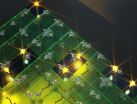Deciphering the neural code that links food to aging
2015-05-12
(Press-News.org) Diet exerts a major impact on health and ageing. The nervous system plays an important role in this process but, thus far, how food signals are interpreted by the nervous system has been a mystery. This is an important question because the perception of food by the nervous system impacts not just ageing, but also other processes associated with health and disease, including metabolism, reproduction, and development.
A new study published in eLife by researchers from the MRC Centre for Developmental Neurobiology (MRC CDN) at the Institute of Psychiatry, Psychology & Neuroscience (IoPPN), King's College London, in collaboration with engineers from the Georgia Institute of Technology (USA), has found that serotonin and TGF-beta hormone levels in specific neurons of C. elegans communicate information about food abundance in roundworms. These signals from the nervous system influence the animal's lifespan, thus mediating the effects of food on ageing.
This work resulting from an interdisciplinary collaboration, not only reveals the links from food to lifespan, it also sheds further light on how the nervous system processes information. In particular, an unexpectedly intricate regulation in this neural gene circuit that also alters the accuracy of its gene expression signals has been discovered. Thus, gene expression can also serve as an additional layer of computation in the nervous system. This work reveals how food signals are processed, and how the accuracy of its corresponding neural code is regulated.
'By having biologists work closely with engineers, we could bring to bear a combination of biology, automation, and computation on the issue of neural coding that's fundamental to neuroscience. It's the first time neural gene expression has been analysed with this level of detail in a multicellular animal, which was critical in calculating the accuracy of this neural gene expression code and how it was affected by different genes.' said Dr. QueeLim Ch'ng, senior co-author of the study, from the IoPPN at King's College London. 'Most people think about electrical activity when they think about encoding information in the nervous system. Our work shows that gene expression is an important, but virtually unexplored aspect of information processing in the nervous system.'
Both serotonin and TGF-beta pathways have been implicated in diverse human diseases, including cancer, mental disorders, diabetes, and obesity. The powerful genetic tools in the simple roundworm have already revealed many genetic pathways that underlie human physiology and disease, because many important genes function similarly in roundworms and humans.
'Our research will continue to illuminate the pathways and mechanisms that link diet to health and disease, while simultaneously uncovering general principles of information processing, which will be crucial for tackling complex gene-environment interactions that underlie many diseases.'
INFORMATION:
ELSE PRESS RELEASES FROM THIS DATE:
2015-05-12
To measure distances in the Universe, astronomers use Cepheids, a family of variable stars whose luminosity varies with time. Their role as distance calibrators has brought them attention from researchers for more than a century. While it was thought that nearly everything was known about the prototype of Cepheids, named Delta Cephei, a team of researchers at the University of Geneva (UNIGE), the Johns Hopkins University, and the European Space Agency (ESA), have now discovered that this star is not alone, but that it has a hidden companion. A revelation published in The ...
2015-05-12
MADISON, Wis. -- Expansion of cattle pastures has led to the destruction of huge swaths of rain forest in Brazil, home to the world's largest herd of commercial beef cattle. But a new study led by the University of Wisconsin-Madison's Holly Gibbs shows that market-driven "zero deforestation agreements" have dramatically influenced the behavior of ranchers and the slaughterhouses to which they sell.
Publishing today [May 12, 2015] in the journal Conservation Letters, the research team - including other UW-Madison scientists, the National Wildlife Federation, and IMAZON ...
2015-05-12
Scientists from Oregon State University have discovered that fish can produce their own sunscreen. They have copied the method used by fish for potential use in humans.
In the study published in the journal eLife, scientists found that zebrafish are able to produce a chemical called gadusol that protects against UV radiation. They successfully reproduced the method that zebrafish use by expressing the relevant genes in yeast. The findings open the door to large-scale production of gadusol for sunscreen and as an antioxidant in pharmaceuticals.
"The fact that the compound ...
2015-05-12
Extremely high levels of cardiovascular risk factors have been found in people with established psychosis, with central obesity evident in over 80 per cent of participants, in a study by researchers from the NIHR Biomedical Research Centre at the South London and Maudsley NHS Foundation Trust (SLaM) and King's College London.
In the largest study of its kind in the UK, drawing on a sample of more than 400 outpatients with psychosis, it was discovered that nearly half of the sample were obese (48 per cent), with a body mass index (BMI) of 30 or more. Additionally, nearly ...
2015-05-12
Around 55 million years ago, an abrupt global warming event triggered a highly corrosive deep-water current to flow through the North Atlantic Ocean. The origin of this corrosive water has puzzled scientists for a decade.
Now, researchers have discovered this current and how it formed. The findings, published today in Nature Geoscience, also have profound implications for the sensitivity of our current climate to carbon dioxide emissions.
The researchers explored the acidification of the ocean that occurred during a period known as the Paleocene Eocene Thermal Maximum ...
2015-05-11
A low platelet count can occur as the result of a variety of medical conditions and as a medication side effect. Platelet transfusion is often required for individuals with a critically low platelet level. Currently, the primary source of platelets is volunteer donors. Unfortunately, donated platelets have an extremely short shelf life and can be in limited supply. A new study in the Journal of Clinical Investigation reports on a method to generate progenitor cells from murine embryonic stems that are able to produce a large number of functional platelets. Mitchell Weiss ...
2015-05-11
Bacterial meningitis is a life-threating infection of the central nervous system. Group B Streptococcus (GBS) is the leading cause of meningitis in newborn babies and can cause severe complications in those that survive the infection. GBS must cross the blood-brain-barrier (BBB) to cause disease but it is not clear how these organisms breach this barrier. A new study in the Journal of Clinical Investigation identifies a pathway that is induced by GBS and disrupts junctions between cells. Kelly Doran and colleagues at San Diego State University determined that GBS induces ...
2015-05-11
PROSSER, Wash. - Washington wine grape vineyards experimenting with sustainable pest management systems are seeing an unexpected benefit: an increase in butterflies.
Over the years, loss in natural habitat has seen the decline in numbers of around 50 species of butterflies in eastern Washington. But in a recent Washington State University study published in the June issue of the Journal of Insect Conservation, researchers found that vineyards that create nearby natural habitats have three times the number of butterfly species and four times more butterflies than conventional ...
2015-05-11
In what marks a significant step forward for artificial intelligence, researchers at UC Santa Barbara have demonstrated the functionality of a simple artificial neural circuit. For the first time, a circuit of about 100 artificial synapses was proved to perform a simple version of a typical human task: image classification.
"It's a small, but important step," said Dmitri Strukov, a professor of electrical and computer engineering. With time and further progress, the circuitry may eventually be expanded and scaled to approach something like the human brain's, which has ...
2015-05-11
TORONTO (May 11, 2015) -- Immigrants from the Caribbean and Bermuda, as well as refugees from East Africa and South Asia, have a 1.5 to 2 times higher risk of psychotic disorders compared to the general population of Ontario, Canada, according to a new study by researchers at the Institute for Clinical Evaluative Sciences (ICES) and the Centre for Addiction and Mental Health (CAMH). The study also found that immigrants from Northern Europe, Southern Europe and East Asia had about half the risk of psychotic disorders compared to the general population.
The study published ...
LAST 30 PRESS RELEASES:
[Press-News.org] Deciphering the neural code that links food to aging



